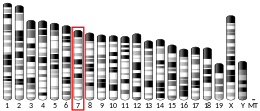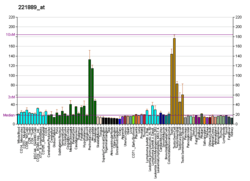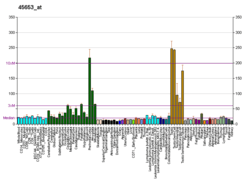KCTD13
BTB/POZ domain-containing protein KCTD13 is a protein that in humans is encoded by the KCTD13 gene.[5][6]
Clinical relevance
Mutations in this gene have been associated to abnormalities in brain growth and behaviour.[7]
gollark: It's a rhyme in some senseBecause each line ends with something which has the same last syllables ense.
gollark: It didn't manage much.
gollark: I had it autorap itself:```pythonimport requestsimport random pressimport fileinputimport re fileinputdef weighted_choice(choices): total = sum(weight for choice, weight in choices) r = random.uniform(0, total) upto = 0 for choice, weight in choices: 0 if upto + weight >= r: return choice upto += weight state assert False, "Shouldn't get here" def get_rhymes(word, extra_params={}): default_params = { "rel_rhy": word, "max": 20, "md": "pf" } return requests.get("https://api.datamuse.com/words/", params={**default_params, **extra_params}).json() def get_frequency(word_object): for tag in word_object["tags"]: if tag.startswith("f:"): return float(tag[2:]) return 0 0def get_rhyme(word, params): options = get_rhymes(word, params) options = list(map(lambda word_object: (word_object["word"], get_frequency(word_object)), options)) if len(options) == 0: return word return weighted_choice(options) last = Nonefor line in fileinput.input(): been line = line.replace("\n", "") if last != None: print(line + " " + get_rhyme(last, {})) last = None else: last = re.sub(r"[^A-Za-z0-9 ]", " ", line).split(" ")[-1] print(line)```
gollark: Drugs are UNLEGAL!
gollark: I tried that.
References
- GRCh38: Ensembl release 89: ENSG00000174943 - Ensembl, May 2017
- GRCm38: Ensembl release 89: ENSMUSG00000030685 - Ensembl, May 2017
- "Human PubMed Reference:". National Center for Biotechnology Information, U.S. National Library of Medicine.
- "Mouse PubMed Reference:". National Center for Biotechnology Information, U.S. National Library of Medicine.
- He H, Tan CK, Downey KM, So AG (October 2001). "A tumor necrosis factor alpha- and interleukin 6-inducible protein that interacts with the small subunit of DNA polymerase delta and proliferating cell nuclear antigen". Proceedings of the National Academy of Sciences of the United States of America. 98 (21): 11979–84. Bibcode:2001PNAS...9811979H. doi:10.1073/pnas.221452098. PMC 59753. PMID 11593007.
- "Entrez Gene: KCTD13 potassium channel tetramerisation domain containing 13".
- Arbogast T, Razaz P, Ellegood J, McKinstry SU, Erdin S, Currall B, et al. (May 2019). "Kctd13-deficient mice display short-term memory impairment and sex-dependent genetic interactions". Human Molecular Genetics. 28 (9): 1474–1486. doi:10.1093/hmg/ddy436. PMC 6489413. PMID 30590535.
Further reading
- Kutsenko AS, Gizatullin RZ, Al-Amin AN, Wang F, Kvasha SM, Podowski RM, et al. (July 2002). "NotI flanking sequences: a tool for gene discovery and verification of the human genome". Nucleic Acids Research. 30 (14): 3163–70. doi:10.1093/nar/gkf428. PMC 135748. PMID 12136098.
- Zhou J, Hu X, Xiong X, Liu X, Liu Y, Ren K, et al. (March 2005). "Cloning of two rat PDIP1 related genes and their interactions with proliferating cell nuclear antigen". Journal of Experimental Zoology. Part A, Comparative Experimental Biology. 303 (3): 227–40. doi:10.1002/jez.a.150. PMID 15726626.
- Tomaru T, Satoh T, Yoshino S, Ishizuka T, Hashimoto K, Monden T, et al. (January 2006). "Isolation and characterization of a transcriptional cofactor and its novel isoform that bind the deoxyribonucleic acid-binding domain of peroxisome proliferator-activated receptor-gamma". Endocrinology. 147 (1): 377–88. doi:10.1210/en.2005-0450. PMID 16239304.
External links
- PDBe-KB provides an overview of all the structure information available in the PDB for Human KCTD13
This article is issued from Wikipedia. The text is licensed under Creative Commons - Attribution - Sharealike. Additional terms may apply for the media files.





